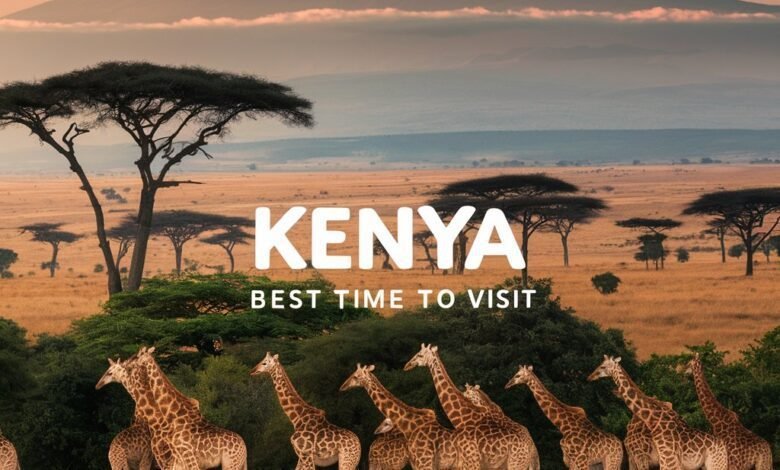
Kenya, a jewel of East Africa, captivates visitors with its diverse landscapes, rich wildlife, and vibrant culture. From the vast savannahs of the Maasai Mara to the lush forests of the Aberdare Range, Kenya offers a myriad of experiences for travelers throughout the year. However, the optimal time to visit this enchanting country depends on various factors, including weather patterns, wildebeest wildlife migrations, and personal preferences. In this comprehensive guide, we explore the best time to visit Kenya, taking into account climate conditions, wildlife sightings, and cultural events.
Understanding Kenya’s Climate:
Kenya experiences a diverse climate due to its varied topography and geographical location near the equator. Generally, the country has two main seasons: the dry season and the rainy season. The dry season typically occurs from June to October, while the rainy season extends from November to May. However, Kenya’s climate varies across different regions, ranging from arid and semi-arid landscapes to highland areas with cooler temperatures.
The Best Time for Wildlife Safaris:
One of the primary reasons travelers flock to Kenya is for its unparalleled wildlife viewing opportunities. The country is renowned for its national parks and reserves, which host an abundance of iconic African species, including lions, elephants, giraffes, and rhinos. The timing of your safari adventure greatly influences the wildlife sightings you may encounter.
Dry Season (June to October):
The dry season, particularly from July to September, is widely regarded as the best time for wildlife safaris in Kenya. During this period, vegetation is sparse, and water sources become limited, compelling animals to congregate around remaining waterholes and rivers. This concentration of wildlife makes it easier for visitors to spot the “Big Five” and other sought-after species.
Moreover, the dry season coincides with the Great Wildebeest Migration, one of nature’s most spectacular events. Millions of wildebeests, zebras, and gazelles migrate from Tanzania’s Serengeti National Park to Kenya’s Maasai Mara Reserve in search of fresh grazing lands. Witnessing this awe-inspiring migration, typically between July and October, is a bucket-list experience for many travelers.
Rainy Season (November to May):
While the rainy season may deter some visitors due to the occasional downpours and muddy roads, it offers its own unique wildlife experiences. The landscape transforms into a lush green paradise, attracting herbivores in search of fresh vegetation. Birdwatching enthusiasts will also appreciate the increased bird activity during this time, as migratory species flock to Kenya’s wetlands and forests.
Additionally, the low tourist numbers during the rainy season mean you can enjoy a more intimate safari experience, with fewer vehicles crowding around wildlife sightings. Certain national parks, such as Amboseli and Tsavo, are particularly scenic during the rainy season, with clear views of snow-capped Mount Kilimanjaro and verdant landscapes.
Choosing the Right Safari Destination:
Kenya boasts an array of national parks and reserves, each offering its own distinct landscapes and wildlife encounters. Depending on your interests and preferences, here are some top safari destinations to consider:
– Maasai Mara National Reserve: Known for its vast plains, abundant wildlife, and the Great Wildebeest Migration, the Maasai Mara is a quintessential safari destination.
– Amboseli National Park: Renowned for its iconic views of Mount Kilimanjaro and large herds of elephants, Amboseli offers a picturesque backdrop for wildlife photography.
– Tsavo National Parks: Divided into Tsavo East and Tsavo West, these parks are celebrated for their diverse terrain, including lava flows, rocky outcrops, and the scenic Mzima Springs.
Other Considerations:
In addition to wildlife safaris,Kenya safaris offers a plethora of cultural experiences and outdoor activities year-round. From visiting traditional Maasai villages to embarking on hiking expeditions in the Aberdare Range, there’s no shortage of adventures to embark on.
When planning your trip to Kenya, consider factors beyond weather and wildlife. Take into account special events and festivals, such as the Maasai Mara Marathon or the Lamu Cultural Festival, which showcase Kenya’s rich cultural heritage and traditions.
Conclusion:
The best time to visit Kenya ultimately depends on your interests, preferences, and priorities. Whether you’re drawn to the drama of the Great Wildebeest Migration or prefer the tranquility of a rainy season safari, Kenya offers something for every type of traveler throughout the year. By understanding the country’s climate patterns, wildlife migrations, and cultural calendar, you can make the most of your visit and create unforgettable memories in this enchanting East African paradise.



